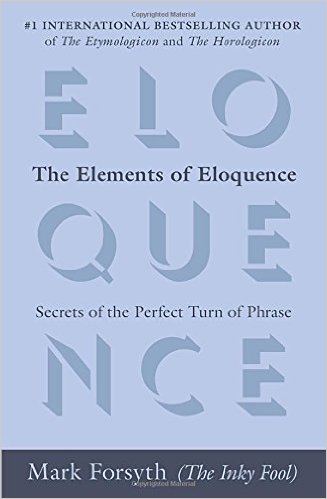The Elements of Eloquence
I want to share a book I read recently that I absolutely loved: The Elements of Eloquence by Mark Forsyth.

My introduction to this book was this tweet:
Forsyth devotes one chapter to each figure of rhetoric identified by the Ancient Greeks. He describes them as, "...techniques for making a single phrase striking and memorable just by altering the wording." Some figures are familiar friends like alliteration. Some figures like hendiadys evade ease and detection. Some figures work across sentences like these three that start with the same words: anaphora. Of course you don't need to know the figures of rhetoric to use or appreciate them, but knowing how they work can help you employ them strategically.
The most fun aspect for me was the way Forsyth uses each figure to describe that figure throughout each chapter. Identifying each use became something of a puzzle to solve while learning about how puzzles work. Forsyth also frequently gives a prime example of each figure that everyone knows. Then he draws on everything from Shakespeare to poetry to music lyrics to illustrate each one. He demonstrates that rhetorical figures aren't a dusty relic, they're a part of the natural way we use language that we can tune into and appreciate.
It was a joy to read and joy is in need. And like all correct-thinking people, Mark Forsyth has a blog. It's The Inky Fool.

My introduction to this book was this tweet:
I felt like I was getting a glimpse at the source code that runs English. Not at the syntax and grammar level (though there is a bit of that), but the presentation layer. I got the preview from Amazon and stumbled on this passage:Things native English speakers know, but don't know we know: pic.twitter.com/Ex0Ui9oBSL
— Matthew Anderson (@MattAndersonBBC) September 3, 2016
A poet is not somebody who has great thoughts. That is the menial duty of the philosopher. A poet is somebody who expresses his thoughts, however commonplace they may be, exquisitely. That is the one and only difference between the poet and everybody else.That passage felt like demystifying a mystical process and from there I was hooked. I ordered the book and read it cover to cover.
Forsyth devotes one chapter to each figure of rhetoric identified by the Ancient Greeks. He describes them as, "...techniques for making a single phrase striking and memorable just by altering the wording." Some figures are familiar friends like alliteration. Some figures like hendiadys evade ease and detection. Some figures work across sentences like these three that start with the same words: anaphora. Of course you don't need to know the figures of rhetoric to use or appreciate them, but knowing how they work can help you employ them strategically.
The most fun aspect for me was the way Forsyth uses each figure to describe that figure throughout each chapter. Identifying each use became something of a puzzle to solve while learning about how puzzles work. Forsyth also frequently gives a prime example of each figure that everyone knows. Then he draws on everything from Shakespeare to poetry to music lyrics to illustrate each one. He demonstrates that rhetorical figures aren't a dusty relic, they're a part of the natural way we use language that we can tune into and appreciate.
It was a joy to read and joy is in need. And like all correct-thinking people, Mark Forsyth has a blog. It's The Inky Fool.